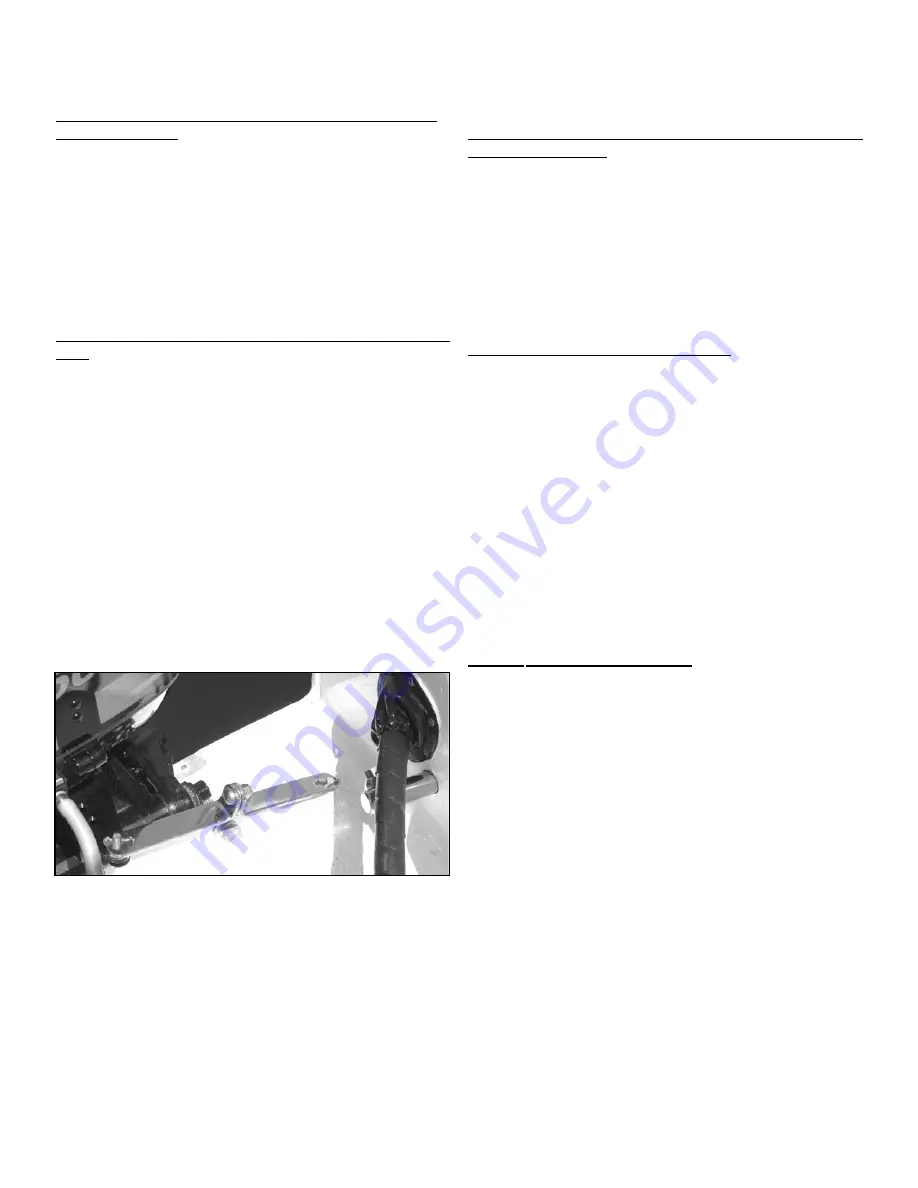
bar together should be loose enough to allow the bar to pivot as
the engine is raised up and down.
When powering, the engine should be connected to the rudders
with the linkage bar. With the engine linked to the rudders, the
rudders will still turn when the engine is turned, but the blades.
when raised, will be waving harmlessly in the air, which is fine
.
With the rudders down at high speed, you run the risk of bend-
ing the rudder heads, or overloading and damaging the steering
system, or contributing to capsize. You also run the risk of the
rudders hitting something and being damaged. With rudders up,
the boat steers fine at the higher speeds with just the engine.
Also, the rudders create a lot of unnecessary drag, and can knock
a few miles per hour off the top speed. Pull them up!
When powering at 6 mph or less, you can steer with the rudders
down. With the engine and rudders linked and the rudders down,
control at low speed is as good or better than any other boat. At
low speed, you will have even better steering control if the cen-
terboard is about 1/4 down. Remember to pull it all the way up
when you are powering faster than 6 mph.
When under sail, you can keep the rudders and engine linked with
the engine retracted, with only a slight increase in the load on the
steering wheel.
If you are racing, or want less load on the wheel, you can discon-
nect the retracted engine so it won’t turn with the rudders. This
takes a relatively small load off of the wheel. To keep the engine
from flopping from side to side as the boat leans, you can discon-
nect the linkage bar from the tube coming out of the hull, and drop
it over the stud protruding up from the deck near the motor well.
Linkage bar on deck bolt
The boat will be a little faster under power with the ballast tank
empty, but you will be a lot safer with the ballast tank full. Please
reread the section on stability. This information is really impor-
tant.
It is possible to drain the ballast tank while moving under power.
You have to be going about 7 mph. Open the vent plug and the
valve on the transom. The nose of the boat will be high and grav-
ity will drain the tank.
When the tank is empty, immediately close the vent plug and the
transom valve, or the tank will again fill with water. Always make
sure the vent and valve are closed except for times when the tank
is emptying or filling. (At dockside, a hose end siphon inserted in
the vent hole will empty the tank in about 12 minutes.)
When powering at any speed over 6 mph, make sure the dagger-
board is all the way up. At high speed, with the board down, the
board will create lifting forces to the right and left as the boat
moves through the water, tending to make it unstable. This could
possibly cause capsize. Check frequently to make sure the board
stays up during powering. This is important.
If the boat is loaded with a lot of weight on one side, it may cap-
size. Make sure the weight in the boat is placed so that the boat
remains reasonably level when underway when traveling in a
straight line.
Do not power over 6 mph with the sails up. If you are going 20
miles per hour in calm air, and the boat is turned, it will slide side-
ways and you will now have a wind of 20 mph filling your sails.
The result could be a knockdown or capsize.
Make sure the mast support wires are tight when powering fast.
The pounding and slamming can otherwise make your mast real-
ly rattle around.
The turning radius at high speed is relatively large, so allow your-
self lots of room.
Most outboard motors have a kill switch that shuts off the engine
if you fall out of the boat. This involves a cable that attaches to
the switch and to you. It is an excellent safety feature, and should
be used.
BOAT MAINTENANCE
LEAKS.
It is a good idea to check the water tank, cockpit, out-
board well and galley vents and drains to make sure all connec-
tions are tight and waterproof. Check the water ballast valve for
leakage as described earlier. Pull the boat out of the water fre-
quently with the water tank full. If anything is leaking, you will
see water coming out.
INSPECTING THE HULL AND DECK.
Periodically inspect
the boat for cracks, delaminations, blisters or signs of impact dam-
age. Gel coat, the outer cosmetic finish, is fairly brittle and occa-
sionally cracks and crazes where it is stressed. This is normally
cosmetic only. If crazing appears, check to see if the fiberglass
itself, and not just the colored gel coat, is damaged.
INSPECTING MAST SUPPORT WIRES AND LIFELINES.
The wires should be checked frequently to make sure there are no
broken strands. If you find a broken strand, replace the wire
immediately.
INSPECTING HARDWARE.
Also check all bolted-on hard-
ware to make sure everything is tight and leak proof. Squirt the
boat with a hose and look for leaks. If one is found, make sure the
bolts are tight and all joints are sealed.
Page 19
Summary of Contents for 26 M 2009
Page 28: ...Page 28...










































